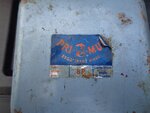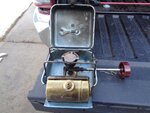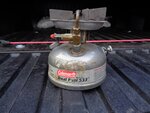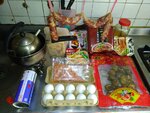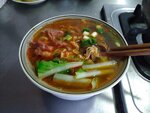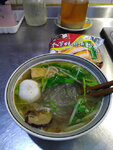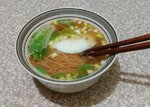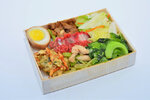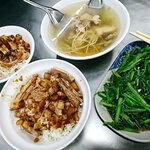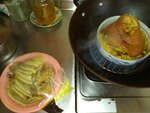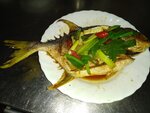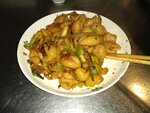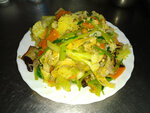Mr. Coffee
Well-Known Member
- Region
- USA
- City
- A Demented Corner of the North Cascades
Eating well and cooking while on a bicycle tour can be a challenge, especially for those who lack experience. This post is intended to at least somewhat demystify that process and give you all some starting points.
Unlike, say, a long-distance backpacking trip or an expedition, the bicycle tourist is most likely traveling through places where suitable food is available for sale. So it rarely makes sense for the bicycle tourist to carry more than a few days supply of food (an exception is if you are planning a basecamp for several days or a week, which becomes a totally different discussion). Learning how to "live off the land" and improvising decent meals from the often limited selection in mini-marts, roadside stands, and the rare supermarket is an actual outdoor skill, just as much as finding a good campsite or navigating a maze of unmarked ranch roads.
One option is to not cook at all -- the cheapest, lightest, and most reliable gear is that which you don't carry at all. If the area you are traveling through is reasonably built up you can probably do just fine with restaurant meals, items from the deli sections at supermarkets, and whatever else you can pick up at mini-marts, fruit stands, and country stores. On my first long bike tour after the first two nights all of our meals were in grocery store parking lots, and we mailed the camp stove and cookpots home.
Cooking over an open fire is a romantic scene. Unfortunately, in much of the civilized world it is now a rare privilege, as total fire bans become more frequent and the lack of easily locatable fuel (or you can purchase bundles of firewood and haul them on your bike) make it a poor idea to depend on an open fire for cooking. In the very best case, cooking over a fire is usually a quite messy process anyway.
Alcohol-fueled stoves are inexpensive (if you search on google you can easily find instructions on how to make one yourself) and fuel is widely available (e.g. as HEET) at mini-marts and auto supply stores pretty much everywhere. The downside of alcohol stoves is that there is no way to control the heat output, and the overall heat output is poor and you can't cook for more than one or two people.
Canister stoves use a pressurized canister, usually with a butane and propane mix, to power the stove. Fuel canisters are generally widely available (outdoor stores, hardware stores, camp stores, sometimes even at big box stores like Wal-Mart), but different kinds of canisters are used in different countries so if you are touring in another country expect to do a bit of research. The stoves themselves are generally inexpensive and quite nice ones are available for less than $40. Another plus is that you can (in the United States) ship the canisters via parcel post, and order them on Amazon or from REI and have them surface shipped to you while on journey. The big downside is that in the absence of a postal scale or a lot of experience it is hard to judge how much fuel is left, and the heat output drops as the fuel is exhausted (this is largely due to the lower pressure in the canister) which means that last pot of coffee might be just barely lukewarm. These stoves perform worse at lower temperatures and at lower altitudes. At very high altitudes they burn hotter than any other fuel. Generally these stoves are best for one or two people. Canister fuel can be rather expensive.
Liquid-fuel stoves usually run off white gas ("Coleman fuel") or kerosene. These stoves are much more efficient and run much hotter in most circumstances than any other stoves. If you are in a larger group they are generally the best choice. They do require a certain amount of maintenance and skill to operate -- in the hands of an inexperienced cook these stoves can be dangerous and scary, and more than a few wildfires have been caused by the incompetent operation of these stoves. Fuel availability is generally good, but it can be quite a challenge to avoid buying a gallon (which is far, far too much to safely carry) of white gas. Some camp stores and outfitters will sell the fuel by the ounce. If you are using a kerosene stove you will need to use a priming fuel (usually alcohol), which you can do with a bit of sterno or HEET.
As for cookware and eating ware, if you are just getting started my recommendation is to go to goodwill. Find a decent but small (usually 1 quart (liter) is plenty big) cookpot, a good-sized plastic bowl, and spoon, fork, and butter knife to taste. Buy a cheap knife at the grocery store, and perhaps improvise a sheath for that knife from cardboard and duct tape. Then you are good to go for not very much money.
You can, however, get fancier if you like.
Evernew and GSI both make some very nice cook pots. Since on bike tour I am probably more likely to be reheating food from a can rather than in the boil-water-and-stir school of backpacking food a nonstick pot is nice. Like I said previously, unless you are cooking for a large group you want the very smallest pots. Providing consistent and smooth heat for frying is a challenge, but if you are up to it look for a small nonstick frying pan and you can make amazing and delicious meals with a bit of effort (if I can hit a grocery store with a decent deli section I will usually raid the salad bar for vegetables and chopped meat and then find packets of teriyaki or sweet and sour sauce to make a quite plausible stir-fry). You can find tiny camp spatulas at REI or just use a plastic spoon.
I usually carry one of the lexan/plastic sporks and find it more than adequate.
For a bowl, I found a 16oz (capacity) nalgene jar with a screw-top lid. This makes a most excellent bowl, cutting board, and you can store your leftover refried beans from dinner for lunch the next day. The jar also makes a great place to make tabouli or other foods that you'd soak for a few hours.
For drinks, I usually carry either a small, cheap mini-mart mug or a well-cleaned yogurt cup as a coffee cup (the whole coffee outside thing is an entire other discussion).
That and a small, cheap kitchen knife from the grocery store and I'm pretty good.
For cleanup, I recommend shop towels, a small piece of sponge (usually I will cut a sponge into quarters and take just one quadrant) and a tiny bit of dish soap (or take something like Dr. Bronner's soap that you can use to wash your stinky body as well as your dishes) and you are pretty much set. Usually I reheat a little bit of water in the dirty cook pot and use that to clean up (you can rinse fine with cold water).
Unlike, say, a long-distance backpacking trip or an expedition, the bicycle tourist is most likely traveling through places where suitable food is available for sale. So it rarely makes sense for the bicycle tourist to carry more than a few days supply of food (an exception is if you are planning a basecamp for several days or a week, which becomes a totally different discussion). Learning how to "live off the land" and improvising decent meals from the often limited selection in mini-marts, roadside stands, and the rare supermarket is an actual outdoor skill, just as much as finding a good campsite or navigating a maze of unmarked ranch roads.
One option is to not cook at all -- the cheapest, lightest, and most reliable gear is that which you don't carry at all. If the area you are traveling through is reasonably built up you can probably do just fine with restaurant meals, items from the deli sections at supermarkets, and whatever else you can pick up at mini-marts, fruit stands, and country stores. On my first long bike tour after the first two nights all of our meals were in grocery store parking lots, and we mailed the camp stove and cookpots home.
Cooking over an open fire is a romantic scene. Unfortunately, in much of the civilized world it is now a rare privilege, as total fire bans become more frequent and the lack of easily locatable fuel (or you can purchase bundles of firewood and haul them on your bike) make it a poor idea to depend on an open fire for cooking. In the very best case, cooking over a fire is usually a quite messy process anyway.
Alcohol-fueled stoves are inexpensive (if you search on google you can easily find instructions on how to make one yourself) and fuel is widely available (e.g. as HEET) at mini-marts and auto supply stores pretty much everywhere. The downside of alcohol stoves is that there is no way to control the heat output, and the overall heat output is poor and you can't cook for more than one or two people.
Canister stoves use a pressurized canister, usually with a butane and propane mix, to power the stove. Fuel canisters are generally widely available (outdoor stores, hardware stores, camp stores, sometimes even at big box stores like Wal-Mart), but different kinds of canisters are used in different countries so if you are touring in another country expect to do a bit of research. The stoves themselves are generally inexpensive and quite nice ones are available for less than $40. Another plus is that you can (in the United States) ship the canisters via parcel post, and order them on Amazon or from REI and have them surface shipped to you while on journey. The big downside is that in the absence of a postal scale or a lot of experience it is hard to judge how much fuel is left, and the heat output drops as the fuel is exhausted (this is largely due to the lower pressure in the canister) which means that last pot of coffee might be just barely lukewarm. These stoves perform worse at lower temperatures and at lower altitudes. At very high altitudes they burn hotter than any other fuel. Generally these stoves are best for one or two people. Canister fuel can be rather expensive.
Liquid-fuel stoves usually run off white gas ("Coleman fuel") or kerosene. These stoves are much more efficient and run much hotter in most circumstances than any other stoves. If you are in a larger group they are generally the best choice. They do require a certain amount of maintenance and skill to operate -- in the hands of an inexperienced cook these stoves can be dangerous and scary, and more than a few wildfires have been caused by the incompetent operation of these stoves. Fuel availability is generally good, but it can be quite a challenge to avoid buying a gallon (which is far, far too much to safely carry) of white gas. Some camp stores and outfitters will sell the fuel by the ounce. If you are using a kerosene stove you will need to use a priming fuel (usually alcohol), which you can do with a bit of sterno or HEET.
As for cookware and eating ware, if you are just getting started my recommendation is to go to goodwill. Find a decent but small (usually 1 quart (liter) is plenty big) cookpot, a good-sized plastic bowl, and spoon, fork, and butter knife to taste. Buy a cheap knife at the grocery store, and perhaps improvise a sheath for that knife from cardboard and duct tape. Then you are good to go for not very much money.
You can, however, get fancier if you like.
Evernew and GSI both make some very nice cook pots. Since on bike tour I am probably more likely to be reheating food from a can rather than in the boil-water-and-stir school of backpacking food a nonstick pot is nice. Like I said previously, unless you are cooking for a large group you want the very smallest pots. Providing consistent and smooth heat for frying is a challenge, but if you are up to it look for a small nonstick frying pan and you can make amazing and delicious meals with a bit of effort (if I can hit a grocery store with a decent deli section I will usually raid the salad bar for vegetables and chopped meat and then find packets of teriyaki or sweet and sour sauce to make a quite plausible stir-fry). You can find tiny camp spatulas at REI or just use a plastic spoon.
I usually carry one of the lexan/plastic sporks and find it more than adequate.
For a bowl, I found a 16oz (capacity) nalgene jar with a screw-top lid. This makes a most excellent bowl, cutting board, and you can store your leftover refried beans from dinner for lunch the next day. The jar also makes a great place to make tabouli or other foods that you'd soak for a few hours.
For drinks, I usually carry either a small, cheap mini-mart mug or a well-cleaned yogurt cup as a coffee cup (the whole coffee outside thing is an entire other discussion).
That and a small, cheap kitchen knife from the grocery store and I'm pretty good.
For cleanup, I recommend shop towels, a small piece of sponge (usually I will cut a sponge into quarters and take just one quadrant) and a tiny bit of dish soap (or take something like Dr. Bronner's soap that you can use to wash your stinky body as well as your dishes) and you are pretty much set. Usually I reheat a little bit of water in the dirty cook pot and use that to clean up (you can rinse fine with cold water).
